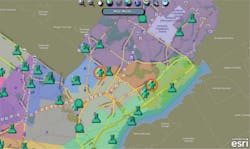Baby Steps to a Smart Water Future
By Katie Umberg
If you had asked utility staff in the year 2000 to imagine how they would be operating in 2020, their vision might have included the use of technology, automation, and real-time information. They would likely be disappointed to learn that, in fact, no significant changes had occurred at their utility — that they would still be tracking maintenance in physical log books, sending crews out to manually open and close valves, using the same rough user interfaces to view data, employing staff to physically read meters, and learning about main breaks via customer calls.
Why has nothing changed for so many utilities, despite the explosion of technology in other areas? Most simply it’s because utilities have not taken strategic steps to upgrade their tools and processes.
There are myriad reasons why utilities have not made upgrades. Many suffer from a lack of resources, and scramble to meet increasing regulations and shifting demands. Many do not have staff with the time or expertise to stay informed of and implement new technologies. There’s also the “if it ain’t broke, don’t fix it” mentality, as utilities stick to methods that have served them for decades. And, admittedly, innovation in this industry has been delayed; utilities have only recently begun pushing vendors to develop innovative products.
But in conversations with utility staff about why they haven’t made any changes, a rarely-discussed reason is that many utilities are misinformed about what is required to develop a strategic plan that encompasses a move toward an intelligent water network. I recently spoke with a utility supervisor who said he has followed my work with online water quality monitoring (OWQM). When I asked what he’s done in that area, he dejectedly said that he hadn’t done anything, as it wasn’t feasible for him to have staff on site 24/7.
His response surprised me because full-time staffing is not at all required for distribution system monitoring.
In recent years I’ve observed two major “smart water” myths. Here they are, followed by examples of achievable steps utilities can take to become smarter.
Custom plots can be developed to show water quality and pressure data in a problem area of the system.
Myth 1: Implementation of smart water technology must be all-encompassing and dramatic, requiring millions of dollars, a tight timeline, and total replacement of existing systems and procedures.
Reality: Not only is this not a requirement but utilities should avoid this if possible. While large-scale changes may be necessary in some cases, it is often more effective to implement technology in smaller, immediately-beneficial steps. In addition to spreading costs over time, staff buy-in is generally easier with more gradual changes, and plans can be refined based on lessons learned along the way.
Myth 2: There is a single, lofty ideal that must be achieved in order to “count” as an intelligent water system, and it requires implementing the latest technologies like real-time modeling, distribution system monitoring, automatic metering (AMI), real-time controls (RTC), drone surveillance, predictive and prescriptive analytics, etc.
Reality: Not true. If you asked ten technology experts to define intelligent water, you’d likely get ten very different, probably vague answers. I don’t know of any single utility that has implemented all of these technologies nor would I suggest that one do so.
One definition of an intelligent water network is one that is managed and operated in an intentional, informed, and proactive way. Instead of reactive decision-making based on breaks and violations, or simply because “that’s how we’ve always done it,” the actionable information available through an intelligent water network empowers utility staff to operate with awareness of current conditions and the ability to monitor the impact of their actions.
In this definition, data management and technology are a means to an end. Technology upgrades are implemented because they help achieve utility-specific objectives or address major challenges — not to simply check a “technology box.” Potential projects (as well as plans for implementing them) are evaluated based on a utility’s priorities, capabilities and resources.
Below are examples of upgrades that are within reach for many utilities. Each provides immediate benefit for utility operations and lays the groundwork for additional technological advances.
Digital logs: Handwritten logbooks provide little value in day-to-day operations; they can be hard to read, inconsistent, and are not easily searchable. Although updating to a digital solution, such as a spreadsheet (see Fig. 1), may not seem like a significant step toward intelligent water, a well-designed interface establishes consistent procedures and data collection — a critical aspect of any intelligent water upgrade. It also introduces use of technology into staff’s day-to-day activities, and the ability to search previous entries gets them used to leveraging this new source of information.
Figure 1. Using a spreadsheet instead of handwritten logs introduces use of technology into staff’s day-to-day activities.
Data communication: A network for transferring data from remote locations to a central data warehouse (such as a SCADA system) is a fundamental requirement for most intelligent water technologies. And as an immediate benefit, staff can have greater awareness of distribution system conditions using real-time operations information (flow, pressure and tank levels) and water quality data (such as chlorine, pH and turbidity).
Well-designed user interfaces: Too many utilities have real-time data coming in that they don’t use. To provide value, data must be available to staff in a usable format. Many utilities’ existing SCADA systems can help. Custom plots can be developed to show water quality and pressure data in a problem area of the system. Clear user interfaces can support real-time distribution system awareness, streamline tedious data review processes, and make staff responsibilities and decision-making easier. Also, getting staff comfortable with and accustomed to regularly reviewing real-time data is critical for implementing intelligent water technology.
Parameter setpoints: With setpoint alarming, utility staff get an alert when a pre-defined threshold for parameter values is surpassed — such as when chlorine drops below the specified value. Many utilities already have setpoint alarming in place for plant data through their SCADA system, but this analysis can be applied to any data stream — including operations and water quality data from the distribution system. Automated alarms inform staff of potential system issues so they can respond quickly and potentially reduce consequences of undesirable conditions. Also, responding to alarms helps shift the utility culture to one of proactive investigation and data interpretation, which is necessary when applying intelligent water technologies.
Customer calls and sample results are shown on a utility map, allowing utility staff to see where abnormal water quality has been observed in customer calls.
Geospatial user interfaces: Viewing data spatially can further support distribution system awareness, providing greater context and helping to make connections between data sources. Icons can be configured to show customer calls and sample results on a utility map; this allows staff to see whether abnormal water quality has been observed in customer calls, and clustered customer calls are easily identified. For utilities with a GIS system, there is significant value in designing or updating geospatial interfaces with available information. Map-based interfaces greatly increase system awareness and get staff familiar with information synthesis. Also, a well-designed interface can easily be updated with additional layers of information as new projects are implemented.
Remote operations: With remote operations, utility staff can change the status of equipment without visiting the site. Utilities often initiate remote operations to address a specific need, such as adding a remotely-controlled flushing hydrant in an area with water age issues that is far from the plant, or adding remotely-controlled valves in an area where they are concerned about potential consequences of a main break. In addition to saving time and allowing for quicker response to problems, this functionality can lead to additional remote management and even automated operations or real-time controls.
It is important to emphasize that, while there certainly are valuable, attainable steps that most utilities can take to improve their technical capabilities, it is critical to develop a strategic plan before starting. Even a low-cost project is wasted if it doesn’t meet a utility-specific need, doesn’t provide new capabilities, or won’t be compatible with future upgrades.
Every utility should develop an intelligent water plan by envisioning a system where they have all the data and tools they need to operate with minimal effort, evaluating existing capabilities and resources, and researching available technology and work by other utilities. System security is also important to address, and utility security protocols and best practices must be followed. External support may be necessary to provide technical expertise, focus the vision and objectives, identify relevant options from the wide range of products and methodologies available, provide realistic estimates of costs and timelines, and suggest a reasonable path forward.
Now is the time to start taking baby steps toward intelligent water so that, 20 years from now, you aren’t in the same place you are today.
About the Author: Katie Umberg is a senior management consultant with Arcadis, supporting water and wastewater utilities in operating more efficiently, effectively, and confidently. She has over 13 years of experience in distribution system monitoring, has served as an advisor for multiple organizations, and has authored numerous publications and guidance materials.
Smarter Water Conservation for Rural Utilities
A new, free app, from the National Rural Water Association (NRWA) is designed to help utilities to increase customer participation in their community’s water conservation efforts while helping them save money.
The NRWA Savings Engine is a software platform that requires no obligation or extra work for utilities. Customers simply need to log on through their mobile phones and answer a few simple water usage questions. NRWA utilities can retrieve valuable data and customers can improve water efficiency, which can ultimately identify money-saving opportunities.
The SaaS-based platform estimates water use and focuses the customer on water conservation efforts while increasing utility outreach and assisting in demand management.
Now available, the NRWA Savings Engine is accessible for any utility to take advantage of this opportunity to engage its customers while conserving valuable resources.
For more information or to join the program, email [email protected].





